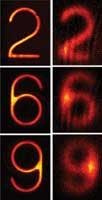Optical storage of information is a tricky obstacle to overcome in the realization of quantum information processing. Complex configurations of photons tend to decay or disperse too quickly to be reconstructed. Moshe Shuker and colleagues at the Technion-Israel Institute of Technology (Haifa, Israel) and the Weizmann Institute of Science (Rehovot, Israel) have reported a method to improve the recovery of arbitrary two-dimensional light fields in a warm vapor of rubidium atoms at 52°C.
The group directed a laser-diode pulse through a stencil of the numeric digits 2, 6, and 9 to excite the atoms in the atomic vapor in the shape of the digits. They used a phenomenon called electromagnetically induced transparency (EIT) to slow the group velocity of the images down to several thousand meters per second. After delays of 2, 6, and 9 µs, respectively, the images were recovered, demonstrating the typical deterioration caused by diffusion over time. Careful manipulation of the phase and intensity of the light pulse enabled the researchers to diminish the effect of diffusion, and to store images of parallel lines 340 µm thick for up to 30 µs, a thousand-fold improvement over previous attempts. Contact Mose Shuker at [email protected].
